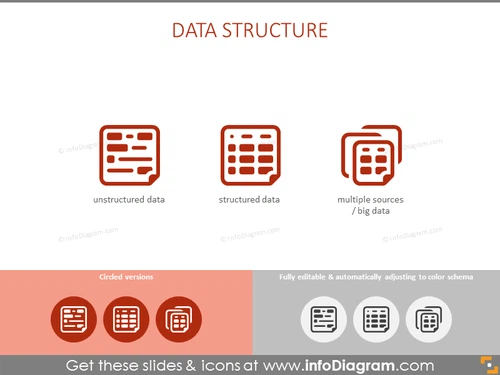infoDiagram
>
Content-ready Topics
>
Data Analytics, IT
>
Data Science Big Data Analytics Icons (flat PPT clipart)
>
Data Structure
Data Structure
from deck
Data Science Big Data Analytics Icons (flat PPT clipart)
- Info
- How To Edit
- Usage example
Info
DATA STRUCTURE
Slide Content
The PowerPoint slide is titled "DATA STRUCTURE" with three main points. "Unstructured data" refers to information that doesn't follow a specified format, making it difficult to collect, process, and analyze. "Structured data" means data that is organized in a fixed field within a record or file, such as spreadsheets, which makes it easily searchable. "Multiple sources / big data" suggests the integration of data from various repositories or formats, indicating complexity and scale.
Graphical Look
- Three symbols representing different data structures aligned horizontally across the top half of the slide.
- Each symbol is paired with its respective text label: "unstructured data," "structured data," and "multiple sources / big data."
- Icons feature a document-like shape with varying internal designs: the first representing unstructured data with random lines, the second showing a grid for structured data, and the third combining elements of both with an added layer suggesting complexity.
- A lower section in contrasting color showcases circled versions of the same icons alongside an explanation about editability and color scheme adaptation.
- The overall color palette is limited, with a soft salmon background matching the circled icon section, and a light color for text and icons providing contrast.
The slide has a clean and modern look with a well-balanced layout. The icons are simple and visually communicate the types of data structures introduced on the slide.
Use Cases
- Presenting in a seminar or workshop about data management to explain different types of data formats.
- During a corporate training session to teach employees about handling various data types in business systems.
- In a sales pitch for data analytics software to showcase the application's capability to process and integrate diverse types of data.
- As part of an educational lecture in information technology or computer science courses discussing the fundamentals of data organization.
How To Edit
How to edit text & colors

How to expand / shorten diagram

How to Replace Icons in infoDiagram PPT


